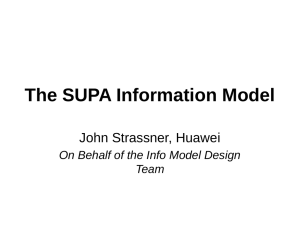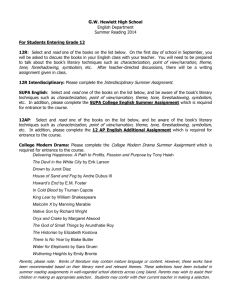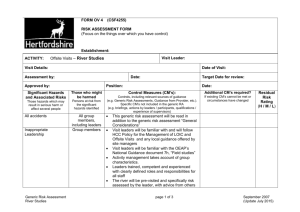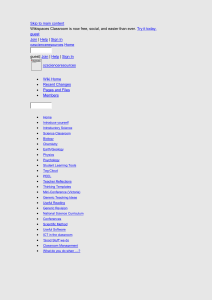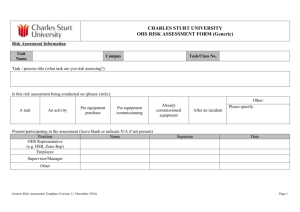3.1 SUPA Value Proposition
advertisement
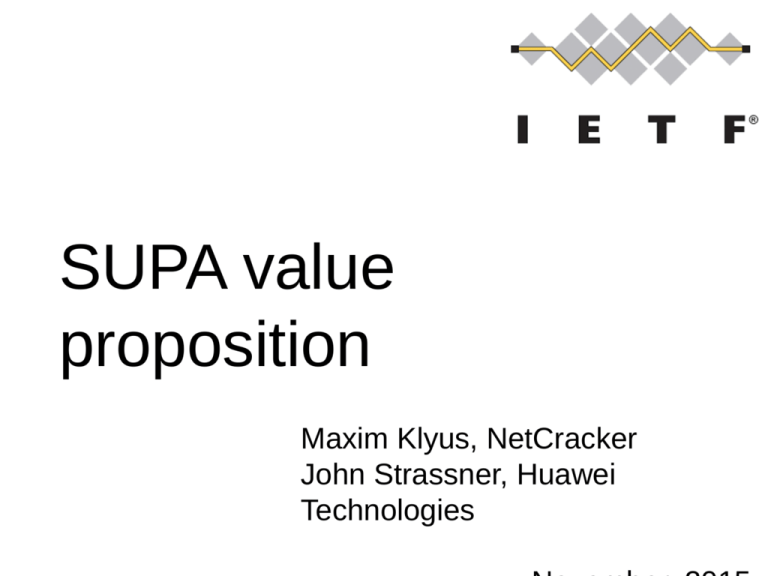
SUPA value proposition Maxim Klyus, NetCracker John Strassner, Huawei Technologies SUPA Proposition I-D Motivation - Combine all existing research work which was done in previous I-Ds - Prepare one concise document which clear shows existing SUPA framework and value - Show basic examples of the Generic Policy applicability Status of the I-D - I-D was not updated since it was the point by itself for SUPA charter definition and discussion - Updates needed to be done: a) Intent-based policy part should be removed b) Policy framework should be addressed to single domain management c) Update SUPA framework and related pictures in the I-D Problem Statement Services Network Multiple Vendors Multiple Technologies Multiple Paradigms Programmatic Control Tools Syntax Data Models SDN, NFV, Legacy CLI, TL1, scripts Semantics Management and Orchestration Challenges - Complicated network infrastructure operation and management - Hard to deploy new and manage existing network services - Difficult to adapt new technologies to existing network operation and management ecosystem Problem Statement Services Network Multiple Vendors Multiple Technologies Multiple Paradigms Programmatic Control Tools Syntax Data Models SDN, NFV, Legacy CLI, TL1, scripts Semantics Policy Management and Orchestration SUPA GPIM – Generic Policy Information Model Unified technology independent operation and management framework based on CA and/or ECA policies will help to solve the challenges and improve existing SP network infrastructure management SUPA Framework SUPA GPIM Defines Policy (CA or ECA) for the set of Network Objects OSS Network Objects Database represents SP Network NE NE Filtering NE and Defining Rules Set of NEs + Set of Rule s for NEs NE SUPA Policy NE NE NE NE NE NE NE NE NE NE NE NE Selecting the set of NEs based on specific policy Defining rules how to handle configuration for selected set of NEs Feeding selection result and rules to internally implemented translation system SUPA Framework defines how to build requests for selecting NEs and applying rules to this NEs based on specific conditions in terms of a specific IETF YANG Data Models POLICY REPRESENTATION INSERT NetworkObjects_DATABASE L4_ACL = “permit snmp 10.10.0.0/16 any” /*rule we need to apply*/ where NetworkObject_TYPE = router /* set of NetObj*/ OSS Orchestration or Translation System under Feeding results the OSS to (Selecting appropriate IETF Translation YANG DM and building System configuration snippets in terms of based on selected NEs and specific Rules IETF YANG DM Each SP can use own Applying internal Configuration implementation how to to NEs translate SUPA Policies to configuration snippets NE NE NE NE Generic Policy Application Examples SUPA Generic Policy - Rule-based - Event, Condition, and Action clauses - Vendor Independent - Technology-agnostic - Real-time network management Generic Policy Application Examples SUPA Generic Policy CA (A) Disable SNMP (C) for all aggregation switches Select all aggregation switches from OSS database. Send SNMP Disable rules to internally implemented Translation System / OSS Orchestration for these switches, which generates configuration snippets by using appropriate IETF YANG Data Models ECA (A) Balance inbound traffic (C) on edge-links (E) in case of edge-interface load more than 70% Select all edge routers from OSS database where interface utilization with incoming traffic is more than 70%. Send Load Balancing Rules for these routers to internally implemented Translation System / OSS Orchestration, which generates configuration snippets by using appropriate IETF YANG Data Models Value and Benefits of SUPA Vendor and Technology Independent Policy Framework Network Policy independence reduces complexity and vendor lockin. Helps unify network management. Simplifies deployment of new Network Function and Services. Unified Network Infrastructure Policy Management Increased abstraction enables simpler and effective network infrastructure management for operators Real-time and event-based Network Management Network infrastructure can automatically changes based on context monitored by policy at the current moment of time New Independent Network Management Layer Policy can help to build intermediate layer between SP and Subscribers for unified and shared management. Policy-holders can provide an instruments to Policy-users for their network resource management. Deliverables and goals Generic Policy Informational Model - SUPA framework defines a generic structure for imperative policies CA and ECA. This is converted to generic YANG data models. The IETF produces the models, and IANA is used to register the model and changes. Generic Policy Framework - Define how to construct Generic Policies for Network Infrastructure (Functions, Services and Intermediate layer) - Define a set of YANG data models that express the concepts defined in the generic policy information model in concrete data models. These models will be designed to be generic and extensible. The SUPA is a way to make the alignment for the Network Infrastructure Management based on Unified Policy approach

